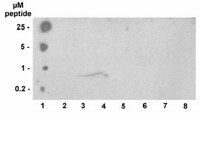Antitumor activity of a small-molecule inhibitor of the histone kinase Haspin.
Huertas, D; Soler, M; Moreto, J; Villanueva, A; Martinez, A; Vidal, A; Charlton, M; Moffat, D; Patel, S; McDermott, J; Owen, J; Brotherton, D; Krige, D; Cuthill, S; Esteller, M
Oncogene
31
1408-18
2012
Show Abstract
The approval of histone deacetylase inhibitors for treatment of lymphoma subtypes has positioned histone modifications as potential targets for the development of new classes of anticancer drugs. Histones also undergo phosphorylation events, and Haspin is a protein kinase the only known target of which is phosphorylation of histone H3 at Thr3 residue (H3T3ph), which is necessary for mitosis progression. Mitotic kinases can be blocked by small drugs and several clinical trials are underway with these agents. As occurs with Aurora kinase inhibitors, Haspin might be an optimal candidate for the pharmacological development of these compounds. A high-throughput screening for Haspin inhibitors identified the CHR-6494 compound as being one promising such agent. We demonstrate that CHR-6494 reduces H3T3ph levels in a dose-dependent manner and causes a mitotic catastrophe characterized by metaphase misalignment, spindle abnormalities and centrosome amplification. From the cellular standpoint, the identified small-molecule Haspin inhibitor causes arrest in G2/M and subsequently apoptosis. Importantly, ex vivo assays also demonstrate its anti-angiogenetic features; in vivo, it shows antitumor potential in xenografted nude mice without any observed toxicity. Thus, CHR-6494 is a first-in-class Haspin inhibitor with a wide spectrum of anticancer effects that merits further preclinical research as a new member of the family of mitotic kinase inhibitors. | Immunofluorescence | 21804608
 |


















